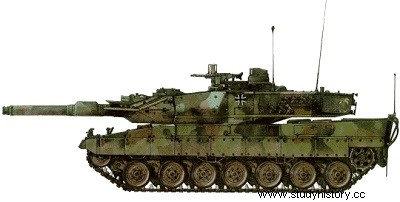
Leopard 2 , battle tank
Features
Crew :4 men.
Weight :55,150 t.
Dimensions :
length with barrel , 9.668 m;
body length , 7.772 m;
width , 3.70 m;
overall height , 2.79 m.
Engine :MTU MB 873 Ka-500 ’ multi-fuel 12-cylinder developing 1,520 hp at 2,600 rpm.
Performance
maximum road speed , 72 km/h;
maximum autonomy, 550 km;
slope 60%;
vertical obstacle , 1.10 m;
trench , 3m.
Armament
Main armament 1 x 120 mm Rh 120 smoothbore gun supplied with 42 shells.
A0 to A5:L/44
A6:L/55
Secondary armament 2 x 7.62mm MG3 machine guns (coaxial and on turret), 4,750 rounds
2 x 8 smoke launchers (on each side of the turret)
At the end of the 1960s, the Federal Republic of Germany and the United States jointly conducted studies for a new main battle tank:the MBT-70. In 1970, the project was abandoned due to excessive cost increases, so West Germany began to develop a new MBT, the Leopard 2. This took over the engine, transmission and some other elements of the MBT-70. A total of sixteen hulls and seventeen turrets were built to test various types of suspensions, weapon systems (one 105 mm or 120 mm smoothbore gun) and fire control. A special version, the Leopard 2 (Austere Version) armed with a 105 mm L7 tube, was later developed to meet any requests from the United States.
After having carried out tests in Germany Federal and across the Atlantic, the Leopard 2 was adopted by the Bundeswehr, and in 1977, one thousand eight hundred of them were ordered (810 to Krupp and 990 to Krauss-Maffei of Munich). Delivery should be completed in 1986. In 1979, the Netherlands chose the Leopard 2 to renew its armored fleet. Four hundred and forty-five copies will be delivered by 1986. Under the terms of the contract, many elements will be supplied by Dutch industry.
Currently, the Leopard 2 and the Abrams MI are undergoing comparative tests in Switzerland, this country needing a more modern vehicle to replace its Centurions and Pz 61s.
The Leopard 2 is armed with a Rheinmetall cannon 120 mm smoothbore that primarily uses two types of ammunition:the HEATMP-T and the APFSDS-T. The former works against all targets on a battlefield (including fortifications and lightly armored vehicles), while the latter pierces the frontal armor of all known tanks, including the T- 64 and the Soviet T-72. The ammunition, also manufactured by Rheinmetall, is original in this. that it has a semi-combustible casing of which only the base remains, once the shot is fired, which is ejected into a bag placed under the breech of the barrel. The payload capacity reaches 42 120mm rounds, which seems low compared to the 60 105mm rounds carried by the first generation Leopard 1. However, this is not a major disadvantage, insofar as the 120 mm shell has a greater
penetration power and its sighting system has greater firing accuracy. . A 7.62 mm machine gun is mounted in the axis of the main armament, and a similar weapon is on top of the turret, for anti-aircraft defense. On either side of the turret are eight smoke launchers that fire forward.
The Leopard 2 tank commander, installed to the right of the turret, has a periscope that can also be used to aim the main armament.
The gunner, who takes the place at the front, under the tank commander, has a stabilized fire control system, including a laser range finder and thermal imaging night vision equipment. The main armament is fully stabilized. Standard equipment includes an NBC protection system, automatic fire-fighting equipment, and a snorkel for fording passages of up to 4 m.
The hull and the turret of the Leopard 2 feature elaborate
armor that is particularly effective against anti-tank weapons with HEAT warheads. The Leopard 2 is powered by a 1,500 hp flex-fuel engine which gives the tank a power to weight ratio of 27 hp/t (compared to 20 hp/t of the latest Leopard 1 models), giving it great acceleration capacity and significant all-terrain mobility, essential elements to ensure the survival of the armored vehicle.
